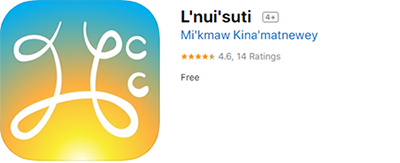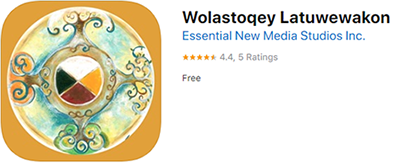

To hear either the Mi’kmaw or Wolastoqey language, you can download one of the apps above.
Mi’kmaw text is written using the Francis-Smith orthography. Where place names exist with an alternate spelling, the spelling in brackets is to aid the teacher in the proper pronunciation of each community name (Francis-Smith orthography).
Mi’kmaq is a noun and is always plural — encompassing more than one Mi’kmaw person.
Mi’kmaw is a singular noun, and an adjective. It is also the name of the language.
Wolastoqewiyik is the name for the group of Indigenous people who live along the Wolastoq (Saint John River). This group was formerly known as Maliseet.
Wolastoqewiyik means people of the beautiful and bountiful river.
Wolastoqey is an adjective.
Wolastoqewiyik are the people.
Wolastoqey Latuwewakon is the language.
Wolastoq is the beautiful and bountiful river.
Passamaquoddy is the name for the entire group of Indigenous people who live alongside or near Passamaquoddy Bay in Maine, United States and New Brunswick, Canada.
Peskotomuhkati is the name of the Passamaquoddy First Nation that inhabits the New Brunswick side of Passamaquoddy Bay.
An app link to a pronunciation guide in these two languages is provided at the top of this page.
Sometimes, materials are referred to as being of Wabanaki origin (Waponahkiyik — Wabanaki People). The Wabanaki Confederacy refers to the Nations of Penobscot (Maine), Passamaquoddy (Maine and New Brunswick), Wolastoqewiyik (New Brunswick, Maine and Québec) and Mi’kmaq (New Brunswick, Nova Scotia, Prince Edward Island, and the island of Newfoundland. There are no Mi’kmaq in Labrador). There are six individual Wolastoqey (Maliseet) communities in New Brunswick, one in Houlton, Maine, and two in Quebec (Viger and Cacouna). There are nine individual communities of Mi’kmaq in New Brunswick, thirteen in Nova Scotia, two in Prince Edward Island, two in Newfoundland and Labrador, and three in Gaspé, Québec. There are no Passamaquoddy communities in New Brunswick; however, there are Peskotomuhkati people living along the west coast in southern New Brunswick. There are two Passamaquoddy communities situated along Passamaquoddy Bay in eastern Maine.
In this document the term First Nation applies to the entire Wolastoqey, Mi’kmaw or Passamaquoddy Nations and NOT to individual communities.
The Three Nations Education Group Inc. and the New Brunswick Department of Education and Early Childhood Development welcome suggestions for improvements to this curriculum resource. Readers are invited to propose activities or any other suggestions for change that may provide support for this document.
We hope you enjoy the unit of study and we welcome your comments and suggestions.
Jason Barnaby, Tim Borlase, Ron Tremblay, August 2021
tim_borlase@hotmail.com




